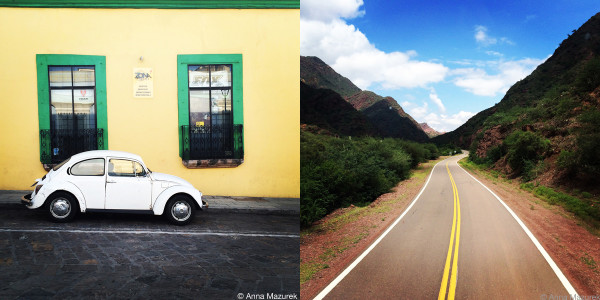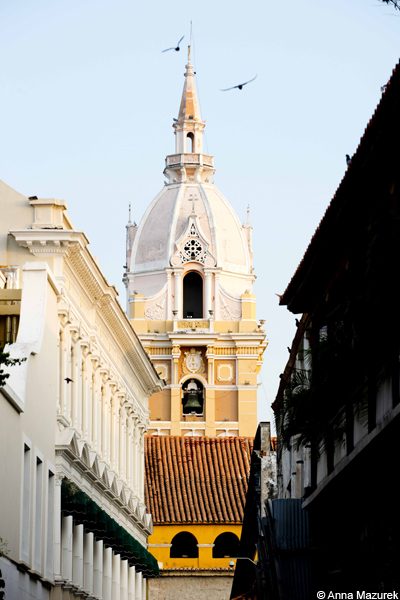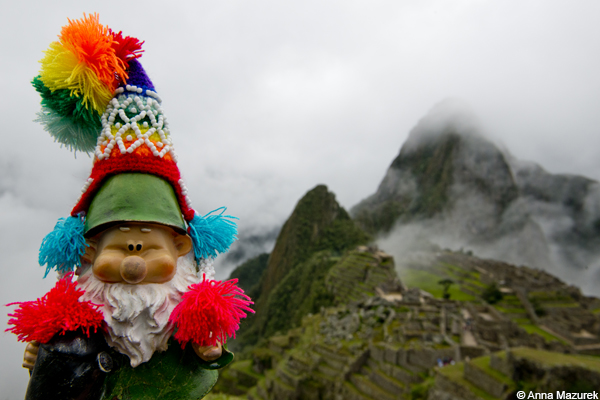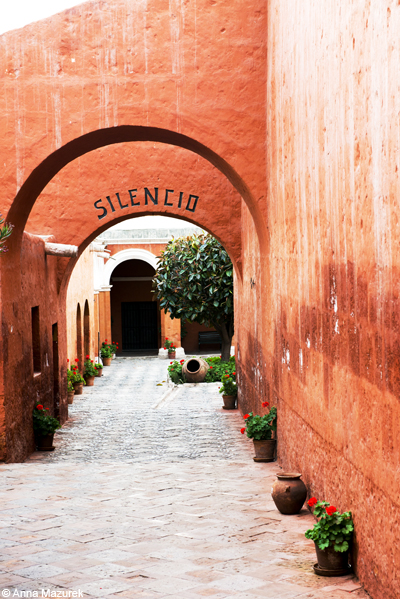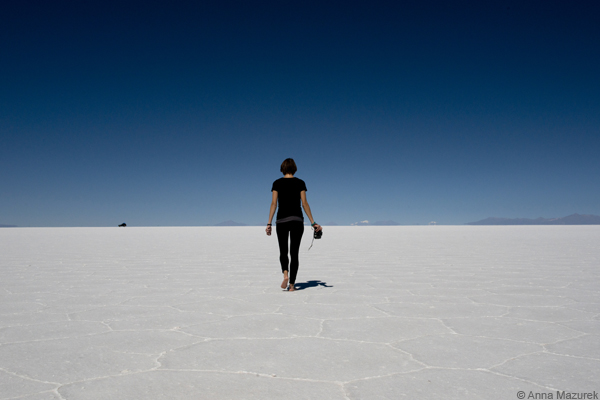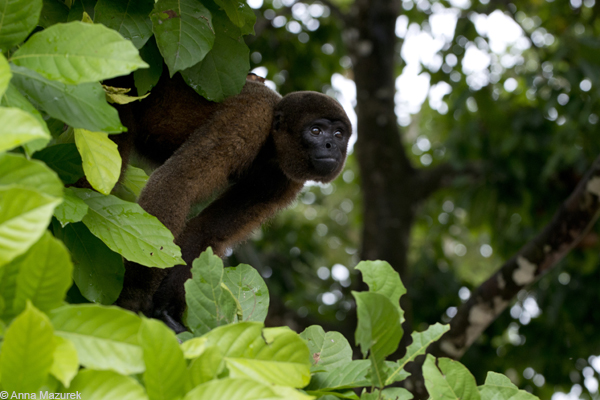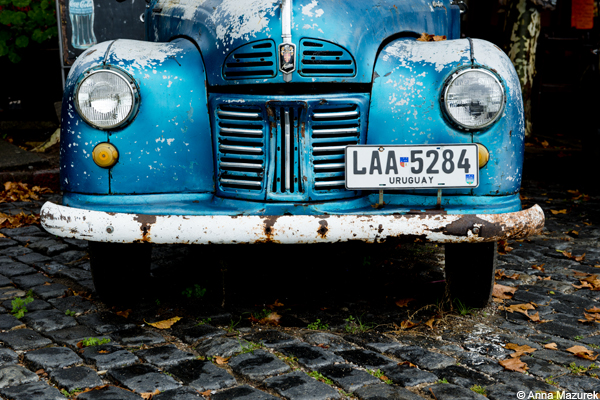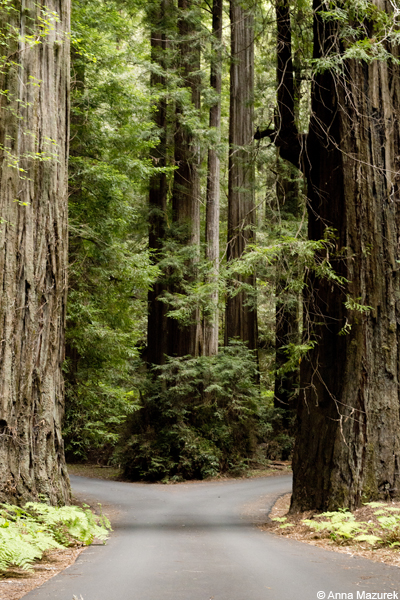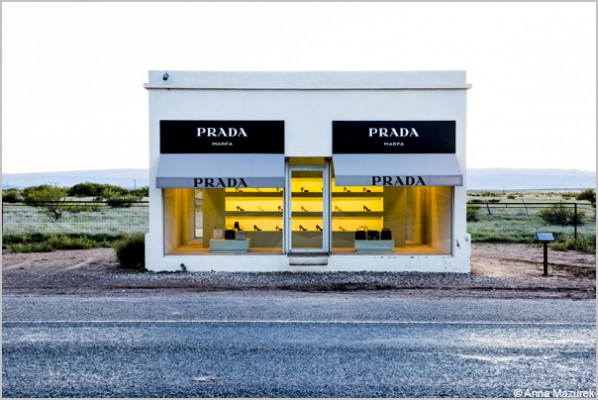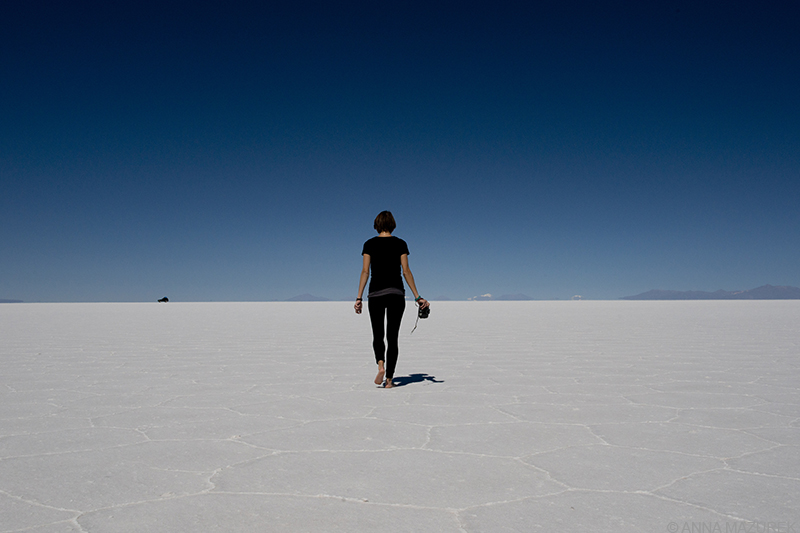
The Real Cost of Travel

Salar de Uyuni (Bolivia) was one of my favorite places in Latin America. I crossed the Andes by bus, which was quite an adventure, and got stuck in Northern Chile for a week due to heavy rains and political protests en route. Nothing worthwhile is every easy.
The biggest myth about travel is that it is outrageously expensive.
I bet it might even be cheaper than where you live now. I spent seven months in Latin America and traveled to 11 countries from October 2014 until May 2015. I tracked every peso, dollar and boliviano I spent in an expense tracking app. I spent hours analyzing the results to provide the detailed and honest breakdown of all my expenses below. (I never want to look at a spreadsheet EVER again!) This includes everything from pay toilets to beer!
Before any big trip, I ELMINATE my bills and focus on saving for travel. In previous posts, I have discussed the cost of travel, solo travel, travel safety, travel banking and how to prepare for a long-term trip. On average, I try to live on $1,000 USD/month no matter where I live. That’s roughly $30/day. In Asia, this was a simple task, but I knew it was a challenge for Latin America due to high transport and visa costs in South America. Before any long-term trip, I like to have at least $10,000 in my savings account, which includes a cushion fund for when I come home. For this trip to Latin America, I saved $15,000 to help cover higher travel costs. To be clear, I have NO debt, which I talked about in a post from 2014.
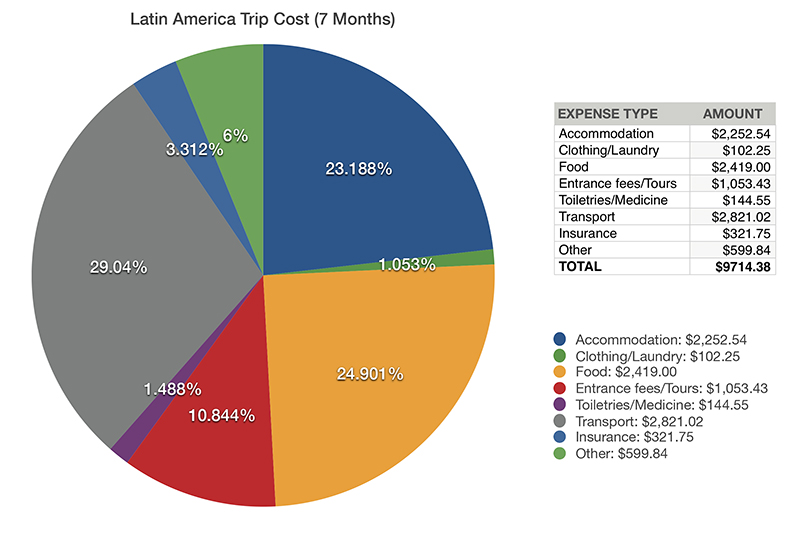
All prices are in U.S. dollars
Total Cost of Trip: $9,714.38
Cost per Month (7-month trip): $1,387
Cost per Day: $46
Countries visited: 11 total including Mexico, Cuba, Panama, Costa Rica, Colombia, Argentina, Chile, Uruguay, Bolivia, Peru and the Maldives (My friends flew me to the Maldives to shoot their amazing wedding!)
Biggest expenses: Machu Picchu ($229 including transport from Cusco and entrance fee only), Peruvian Amazon four-day tour ($402), a month traveling in Patagonia, Torres del Paine ($246.47 including food, entrance fee, rental gear, camping and transport from Puerto Natales, Chile), Cuba ($500 for two week trip); Bolivia Salt Flats ($179); Spanish classes ($259.30)
Summary: Overall, I stayed under my $15,000 budget and still came back to the U.S. with the cushion fund I had budgeted ($5,000). I did spend more than I hoped because I fell in love with Argentina and stayed for two months including one month in Patagonia. Is it possible to do this trip cheaper than I did? Of course! The goal of this post is to show an idea of the actual cost of travel and dispel possible myths. In the end, I do not regret a thing. Every single dollar was worth it!
Detailed Breakdown of All Expenses
Accommodation: $2,252.54
I stayed in dorm beds at hostels for the majority of my trip ranging from $8-$40/night. I shared larger private rooms with groups of friends I met on my travels. I also rented an apartment in Buenos Aires for $35/night and split it with a friend.
Transport: $2,821.02
(Transport $2,545.22 & Visas $275.80)
- This includes every single form of transport (taxi, trains, flights, ferries) and all visas.
- Visas: Argentina $160 reciprocity fee (As of 2016, Americans no longer have to pay this fee.); Cuba $25; Bolivia $60 for one-month entry
- Flights: I flew 15 times and only paid for four flights because I’m a frequent flyer mile ninja. (This does not include the six flights to the Maldives to shoot my friend’s wedding.) Domestic flights in Peru were only 6,000 miles each way so I flew multiple times to save time. I booked award flights a month to six weeks in advance. My trip ended in Lima because it is the cheapest place to fly back to the U.S. from South America. (Trust me, I did tons of research.)
- Overnight buses were my main form of transport. The buses in Argentina were the most expensive—each bus was at least $100. I traveled only by bus and jeep from Ushuaia, the Southern most city in the world to Cusco, Peru.
- I took an overnight ferry from Panama to Colombia for $150 because I refused to pay $400 for a one-way hour-long flight.
- There are only two ways to get to Aguas Calientes, the gateway city to Machu Picchu: take the train or walk for seven hours. I travel with 30 pounds of camera gear (and a gnome) so I gladly paid for the $150 for the scenic train.
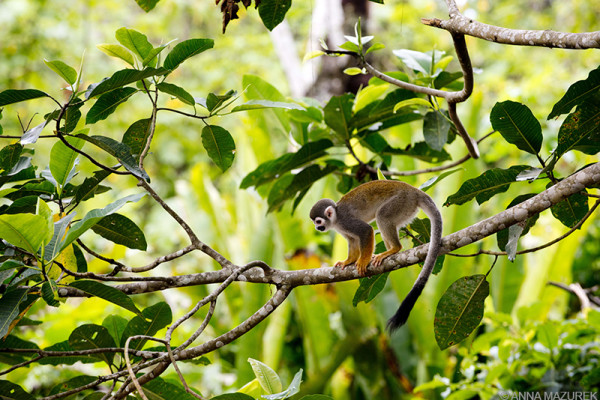
One of the highlights of my trip was a four-day Amazon tour in Iquitos, Peru during the wet season. I photographed this squirrel monkey from our boat on Monkey Island.
Entrance Fees/Tours: $1,053.43
This includes all museums, archeological sites, hiking, national parks and cultural attractions like Machu Picchu admission ($40); 4-day Amazon Tour in Iquitos, Peru ($403.91); Torres del Paine admission ($30); Bolivia Salt Flats tour ($179)
Food: $2,419
(Eating out: $1,565.97; Groceries: $299.92; Beer: $269.99)
- One of my favorite parts of traveling is the food! The older I get, the more I spend on food. I eat well and never eat ramen, but I do eat a lot of peanut butter. Usually, I make peanut butter, banana and honey sandwiches for long bus rides or transit days when food options are limited. (TIP: Always pack a jar of natural peanut butter for a trip – it’s either hard to find or expensive overseas.)
- I ate my weight in steak and fresh berries in Argentina. All of which were extremely cheap.
- I cooked a lot in hostels with other travelers, which meant most meals only cost about a few dollars. I also tried to only stay at places with free breakfast.
- I only spent $13.12 on water because I took a Sawyer MINI water filter with me, which saved a lot of money and plastic. The tap water was drinkable in Argentina, Southern Chile, Panama and certain parts of both Colombia and Costa Rica.
Toiletries/Medicine: $144.55
(Toiletries: $54.39; Medical: $90.16)
- This includes shampoo, medicines like ibuprofen, toothpaste and bandages for when I smashed my knees (and my iPhone) on a morning run in a park in Buenos Aires.
- Contact solution was $20 in Panama! When possible, I ALWAYS buy sunscreen and contact solution in the U.S. before I leave because it’s either hard to find, bad quality or overpriced abroad.
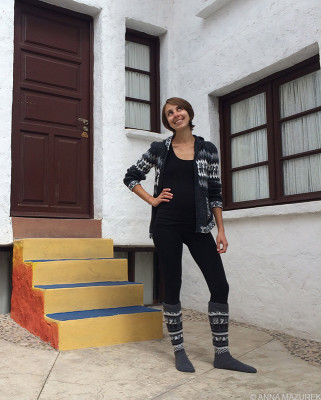
I stocked up on llama clothing in Sucre, Bolivia.
Clothing/Laundry: $102.25
(Clothing: $45.83; Laundry $56.42)
The only clothing items I really bought were socks and a llama sweater/gloves for Bolivia/Peru. I usually only pack for summer because I hate the cold. It’s easier and cheaper to just buy a llama sweater, gloves and socks than drag warm clothing around for five months. For a list of my top 10 things to pack, check out this post.
Insurance: $321.75
I paid $50/month for zero-deductible travel medicine insurance with emergency evacuation coverage and an adventure sports rider through IMGlobal. I opted for the 30-days of home coverage after I returned to give me time to sort out my American insurance. I always cancel my American health insurance when I travel long-term because most U.S. policies offer limited international coverage.
Other Expenses: $599.84
This includes the following: Pay toilets: $3.91; Gifts: $34.65; Postage: $56.92; Spanish classes $259.30; WIFI: $16.42, Tips: $36.17; Other: $192.47
QUESTIONS: Now that I have bared my soul and travel finances to you, I have one small favor to ask. Tell me what topics you would like to see covered on the blog in future posts! What are your travel questions or concerns? Please comment below or email me. I’ll respond as promptly as possible or answer your questions in a detailed post in the future.
COMING UP: Guide to Working Abroad
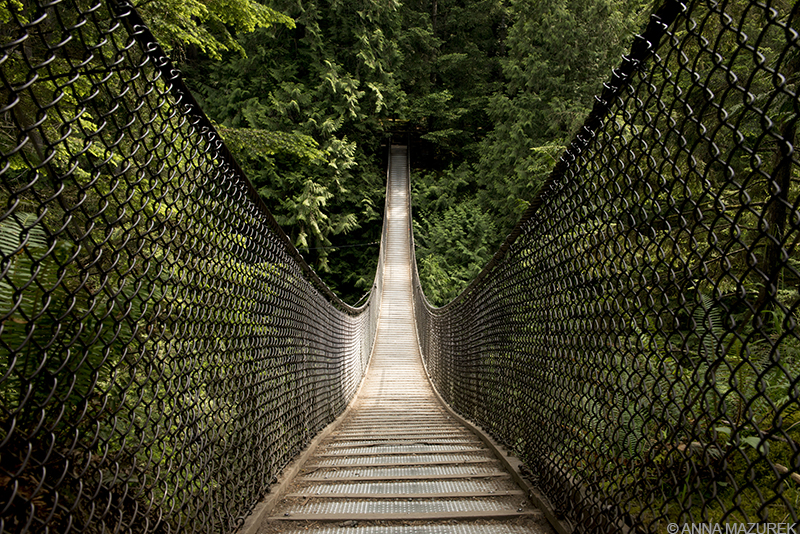
Travel Safety 101

I have this silly fear of heights, which makes suspension bridges like this the scariest part of my travels at times.
Exchanging money on the black market in Argentina is always an adventure. It is just like the plot of a spy movie except – sadly – there is no Jason Statham. The movie started when a friend of a friend (an expat) gave me an address to a building in the swanky part of Buenos Aires with no sign and blinds covering the windows. I rang the doorbell, and the door buzzed open. As the door automatically locked behind me, I panicked. Was I about to die? Or was I just being overly paranoid as usual? After negotiating rates with a Che Guevara lookalike, I was walking down the sidewalk fifteen minutes later with a purse full of pesos and feeling good about my spy skills.
Due to Argentina’s high inflation, the black market is used by literally everyone because the rate is almost 50% higher than the ATM. I did my research beforehand, went to a reputable place and thoroughly checked the bills as I counted them at the counter. I checked again at my apartment, which confirmed my fear was overzealous as usual.
Despite what my mother and the news say, the world is actually a safe place. (Motorized vehicle accidents are the leading cause of unnatural deaths for Americans abroad, according to the New York Times.) I have traveled solo to five continents since 2002; safety is always my top concern. I want to dispel some fears with tips about how to stay safe in case you find yourself living in a spy movie while roaming the globe.
I’ve had my share of mishaps – my purse was stolen in Thailand and again in Barcelona because I was not paying attention—which were both good lessons that helped me stop a pickpocket in Buenos Aires and will hopefully help you as well.
Here are a few tips to help manage your fear and stay safe:
Traveling Warnings & Country Specific Concerns
- Check travel warnings. Before booking flights, research health, environmental, political and terrorism concerns in your destination. Americans should check travel.state.gov for warnings and sign up for the STEP Smart Traveler Program, which provides free email updates.
- Read recent travel guides. These are a good resource for reported safety incidents and high theft areas. (Personally, I felt the safest traveling solo in Japan, Europe, Australia/New Zealand and most of Southeast Asia. I also felt safe in Cuba and Burma. My guard was higher in parts of Mexico, Peru, Nicaragua, Bolivia and India.)
- Avoid areas with military conflicts/elections. Keep in mind that smaller elections may not make international headlines. (I was stuck in Northern Chile for a week due to combination of bad weather that closed the border to Bolivia and rumors of election protests blocking roads across the border. The snow and protests faded a few days later.)
- Dress culturally appropriate. Ladies, be sure to cover up in conservative cultures to avoid unwanted attention. Be respectful when visiting temples. (Some places in Thailand make you rent shawls if you are wearing tank tops or shorts.) Baggy harem pants are a good option for hot places like India and are great for preventing mosquito bites. Both men and women should avoid fancy jewelry and watches especially on public transport.
Get Travel Insurance
The key to insurance is simple: You insure what you can’t afford to pay yourself. I ALWAYS have travel medical insurance that covers emergency evacuation, trip interruption, adventure sports and end of trip coverage (after long-term trips). Most policies will not cover phones and will only pay a flat fee (usually $250) for other electronics. (I insure my camera gear and my Mac separately with State Farm’s Personal Articles Policy.) Many credit cards also include travel insurance benefits like baggage delay, trip interruption and accident coverage.
I always cancel my normal health insurance for long-term trips because American polices have very limited international coverage. Instead, I opt for a zero deductible travel medical policy, which offers better coverage overseas at a fraction of the cost ($30-50/month). I’ve used International Medical Group for years, and they pay claims within 30 days. (I have no affiliation with them.)
Check the Weather
Prices usually drop in the low season for a reason: monsoon season. Be aware of transport issues during monsoon/hurricane/typhoon season. In some places like Thailand, the monsoon season just means a little rain each day. In other places like the Philippines, it means dangerous conditions that can halt transport for days.
Safe Transport
- There is no price for safety. Never risk your safety to save money.
- In high risk areas, avoid local buses for long routes and pay a little extra for private buses. In Peru, I always used Cruz del Sur buses because they were the safest company with private bus stations, secure luggage claim and safe taxis options.
- Never grab a taxi off the street in areas with high crime. Have your hotel, hostel or a restaurant call one instead. Safe radio taxi companies operate in major cities including Meru in India and Tappsi in Colombia.
- Avoid arriving late at night in countries with safety concerns like India, Central America, Peru and Bolivia. If you are taking overnight transport, be sure to arrive during daylight hours in these areas.
- Write down the address of your destination on a piece of paper to hand to the taxi driver. Never give the driver your phone to see the address.
- Research local taxi regulations to ensure your taxi is marked properly before getting inside. Guidebooks and receptionists are good resources.
Tips for Avoiding Theft
- Never carry EVERYTHING with you. Only take the money you need when you go out for the day. Hide your money, passport and credit cards in many different places. The more obscure (like cough drop bags), the better.
- Lock valuables and passports in safes or lockers at hotels/hostels. (I never stay in a hostel that doesn’t have lockers. I bring a sturdy combination lock to secure it. Avoid flimsy suitcase locks and giant high-school-locker-style locks, which are usually too big.
- Watch your bags in crowded places, restaurants and public transport in high risk areas like Barcelona. Put your leg through your bag strap when standing/sitting. Do not hang purses/bags on the back of restaurant chairs or put them in the upper racks on local buses. Keep bags in your lap or at your feet.
- Do not put your phone in your back pocket or lay it on a restaurant table. Break the habit immediately. I always keep mine in my purse, which is always in my lap with the strap across my body.
- Watch your bags on public transport. If you have a purse, ALWAYS keep your hand over the zipper. Move all items in your pockets to one of your front pockets. Keep your hand inside the pocket to secure items. Put your backpack in front of you in crowded places or lock zippers with a suitcase lock.
- Watch out for counterfeit money in places with high inflation. Be aware of all proper watermarks and holograms for the local currency. Check your change carefully in taxis and street markets especially when you are breaking a large bill. Even if you end up with counterfeit currency, don’t worry—it can be passed off fairly easy in street markets. (I was given some fake currency on my last day in Peru. I made a game of spending it all before I left and succeeded!)
- Don’t go into the backrooms (non-public areas) of shops. Have the vendor bring items to the main area. If a shop vendor in India offers you tea, politely decline.
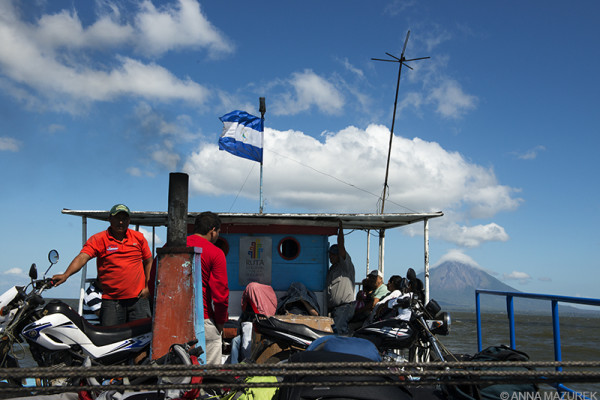
Overweight ferries are a huge safety concern. Don’t take this Ometepe, Nicaragua ferry. ALWAYS get the larger car ferry. (I thought THIS was the biggest ferry at the time.)
Trust your Instinct
Would you walk around the rough parts of your hometown at 2 a.m. with $1,000 cash in your pocket? No? Then, don’t do it abroad! Use common sense. Also, watch your partying. Alcohol and drugs impair your judgment and make you more vulnerable to thieves. (Many of the robberies I’ve heard about in my recent travels happened at night when people were partying or walking alone late at night.) If your gut instinct tells you something is even the slightest bit weird, get out of the situation immediately! Don’t worry about being rude. Get out!
Ask the Locals
I always ask locals for safety advice. Hotel receptionists, guides and expats are great resources. (I never stay in swanky hotels but have no qualms walking into one to ask the concierge about safety concerns.) Is it safe for a foreigner to take a local bus or visit a certain area of town? Do they feel safe in that part of town? If they don’t feel safe or think I won’t be safe, then I avoid the area or the time of day. Other travelers are a great resource as well.
COMING UP NEXT: A Guide to Buenos Aires (my FAVORITE city in the world!)
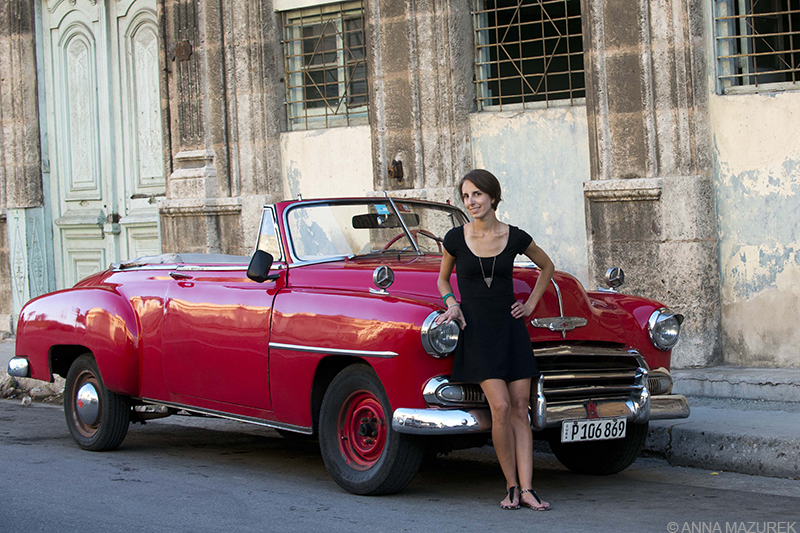
Why I Travel

Obligatory classic car portrait in Havana, Cuba
Why do I travel?
I travel because it makes me feel alive. Truly and completely alive.
I recently read Elizabeth Gilbert’s new story in Condé Nast Traveler magazine, and she inspired me to to write about why I travel and will always continue to travel.
To me, every aspect of life abroad is exciting even just walking down the street. Even those little mundane tasks like riding a bus or going to the ATM are an adventure. I am constantly learning new things and meeting amazing people. (I’ve met some of my best friends on the road and couldn’t imagine my life without them.)
I have this theory: The things that scare you are the things you need to do the most. When I feel comfortable, it’s a sign I need to move on to my next challenge in order to continue to grow.
I was not always this outgoing, adventurous or courageous. All of these skills were acquired by wandering around the globe (mostly solo).
I did not even grow up traveling except for weekend beach trips in the summer and that one trip to Disney World in fifth grade. How does a girl from small town South Carolina grow up to be a vagabond?
The biggest travel inspiration in my life is my 76-year-old Aunt Sandra. She and my uncle were always on some amazing adventure when I was growing up. She always had the best stories—the battle with the scorpion in her Amazon hut, scuba diving in Bonaire and river cruises in Russia. Every time, she brought back souvenirs – jewelry, t-shirts and purses. Eight-year-old Anna loved those Aruba t-shirts. I wore them daily with mismatched Bermuda shorts and dreamed of tropical beaches.
I always wanted to be the one with the cool stories. Now, I am the girl with the stories—photographing the Dalai Lama’s teachings at this temple in Northern India, sledding down the side of a volcano in Nicaragua and spending three days on a train across the Australian outback. Everything I do in life is for the story. I was always a journalist at heart. I am in love with the idea of the story, which is also why I have a Master’s degree in photojournalism.
Above all, my aunt always encouraged my adventures and never once said I was crazy. In August of 2014, I called to ask her opinion of the big trip I was planning in Latin America. I told her my timeline, the list of countries I wanted to visit including Cuba and the amount of money in my savings account ($15,000). I explained how I was marketing the trip to magazines and hoped to continue to freelance as I traveled. Then, I asked: “Should I go now or should I wait another year?”
Her response was immediate.
“Go now,” she replied. “I would if I could.”
Then, she made a great point: “You never know what will happen in those countries politically. If the situation changes, they might not be open for travelers for a long time.” Two months later, I was on a one-way flight to Mexico City with no set plans and unlimited freedom.
It wasn’t my first long-term solo trip, and I admit I was still a little scared—scared of running out of money, getting robbed or getting food poisoning again. But, I refused to let fear rule my life or get in the way of my stories.
I challenge you to answer the same question: Why do YOU travel?
COMING UP: Travel Safety 101
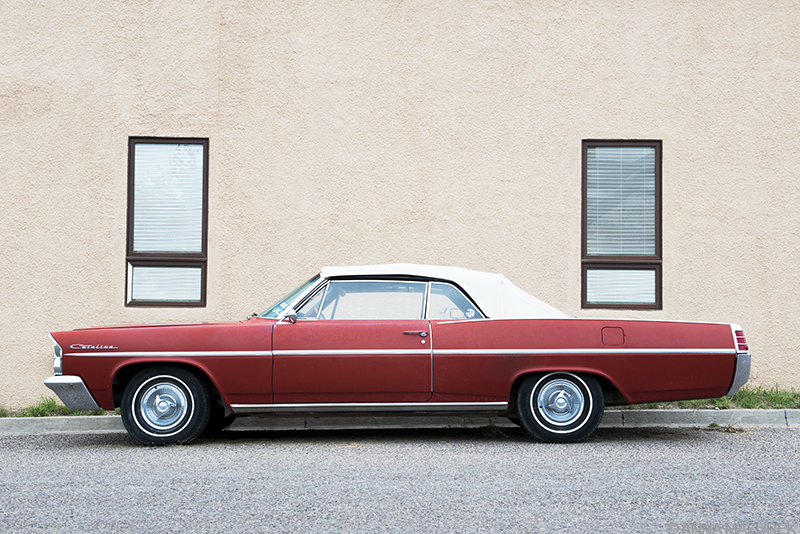
Road Trip Guide to Marfa

Classic Marfa: My favorite town in Texas
I have never been anywhere quite like Marfa.
The quirky, remote West Texas town is one of my favorite places to photograph. (Add it to your bucket list now!) The former railroad town has a population of just under 2,000 people and is a mecca for art. Marfa appeared on the art scene when famed minimalist artist Donald Judd moved to town from New York City in search of a location to permanently install his art. Now, a variety of galleries are scattered across the one-stoplight town along with trendy dive bars and delicious food trucks.
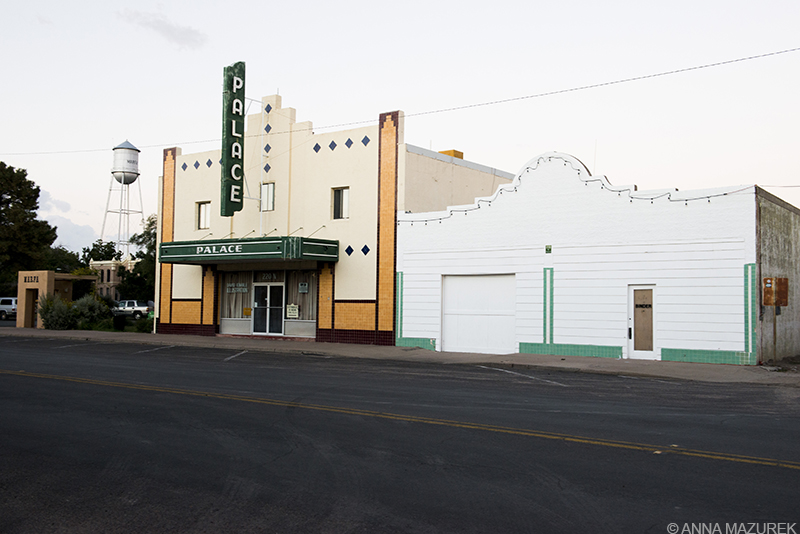
Downtown Marfa, Texas
Thanks to Judd, many people come to Marfa for the art and the hype. The photographic quirkiness of the town is what attracted me to visit. Who could resist the charm of storefronts from the 1800’s restored with a sleek modern touch only a block away from the bustling NAPA Auto Parts? On both of my visits, I drove around everyday at sunrise and sunset looking for things to photograph. I’ve always been drawn to the fringes of life – crumbling colonial towns in Latin America or Buddhist ruins in Asia. In Marfa, I’m drawn to the vintage cars, the former military based Judd turned in a giant art gallery and the dilapidated hotel signs that now stand by vacant lots on the edge of town. Marfa is thriving in a world where small towns struggle to survive.
Marfa does have a bit of third-world charm that adds a bit of adventure: The shops and restaurants don’t always have set hours. They open and close as they please. Good luck finding a place to eat on a Sunday night. (Friday and Saturdays are the best days to visit Marfa.)
People always ask me for tips (where to go/stay/eat) in all the places I’ve been so I’ve started taking good notes and writing up short mini-guides to help! Here’s a quick photo guide to my favorite city in Texas:
1. Marfa Lights
One of the many attractions in Marfa is the mysterious Marfa Lights, which were first documented in 1883. The lights do exist. I’d seen them twice—balls of light that move, fade and twinkle on clear nights between Marfa and the Piasno Pass. A viewing station was built nine miles east of town on Highway 90.

An advertisement for the Marfa Lights outside the quirky Thunderbird Hotel.
2. El Cosmico
El Cosmico is a 21-acre campground with teepees, Mongolian yurts and vintage trailers for rent. They book out far in advance for accommodation. Beyoncé stayed here on her recent visit. I always bring my own tent and chose the self-camp option for $15/person. There’s tons of hammocks, free wifi and a large kitchen.
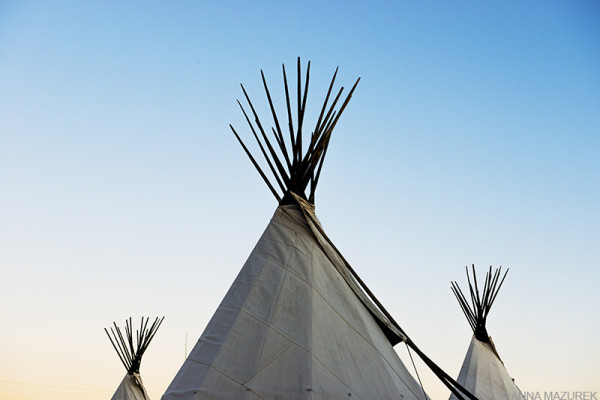
El Cosmico offers a wide range of unique accommodation including three teepees.
3. Marfa Prada
One of the most famous art installations known as the Marfa Prada is actually is 37 miles west of town. The land art project by artists Elmgreen & Dragset was built in 2005 in conjunction with the Ballroom Marfa gallery. It is a replica of a Prada store including shoes and bags donated by Muccia Prada and a door that doesn’t open. The first time I drove out to the building, it had been vandalized, which sadly happens often. On my second trip, the building was repaired and more photogenic. Sunset or sunrise is the best time to photograph the building. There’s no ambient light so avoid going after dark.
4. Food Shark
Food Shark has some of the best food in town. The Mediterranean-inspired food truck with the iconic orange door is open Thursday – Sunday from noon until 3 p.m. The slow-roast pulled pork and okra sandwich is my favorite. Food Shark also runs The Museum of Electronic Wonders and Late Night Grilled Cheese Parlour, a popular weekend eatery packed with vintage TVs. If the inside is full, grab a table on the adjacent renovated school bus eating car to devour your grilled cheese. (Friday & Saturday 9:30 p.m. – 12:30 a.m.)
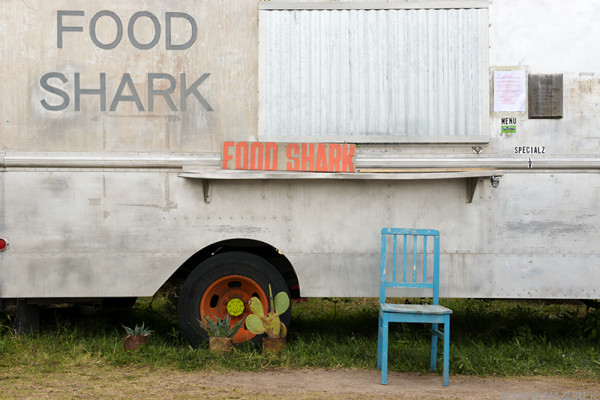
Food Shark runs two delicious eateries in Marfa. It’s a must for lunch!
5. Chinati Foundation
The Chinati Foundation, a contemporary art museum based on the work of Donald Judd, is located on a former military base. Admission is free to Judd’s untitled 15 works of concrete (pictured above) in a field along Highway 67. They offer several tour options: full collection (4 hours/$25 adults), selection tour (2 hours/$20) and a self-guided tour of Judd’s untilted works in mill aluminum ($10 adults).
6. Cobra Rock
On my first trip to Marfa, everyone suggested I visit Cobra Rock Boot Company run by Colt Miller and his partner, Logan Caldbeck. Miller started making boots ten years ago in Borden County near Lubbock, Texas after apprenticing with a cowboy boot maker. The majority of each shoe is stitched on Colt’s 1939 Singer sewing machine. They produce 10 pairs of boots each week, but the entire process takes about three weeks.
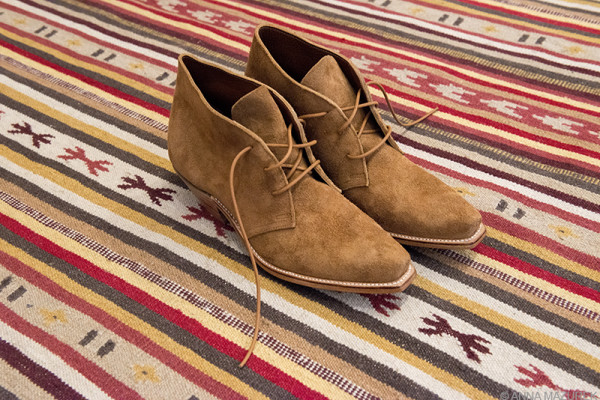 Cobra Rock Boot Company is one of my favorite stores to both photograph and visit in Marfa.
Cobra Rock Boot Company is one of my favorite stores to both photograph and visit in Marfa.
When to go:
- Most restaurants, galleries and shops are open on weekends. Almost everything is open on Saturdays, but Sunday nights are dead. Spring and fall are best for weather. It’s freezing at night from November to March and blazing hot in the summer during the day. Festivals weekends can be really crowded. See the list of events below.
Nearby Attractions:
- Be sure to head up to McDonald Observatory for their Saturday night Star Parties, which include outdoor constellation tours and telescope viewing. It’s usually cold, but the view is amazing.
- Hiking in Big Bend National Park is a must. The wide open desert and giant limestone canyons are incredible. A 4-wheel drive vehicle will make it easier to get to the remote parts of the park.
- Big Bend Brewery in nearby Alpine offers tours at 3 p.m. on Wednesday through Friday and on Saturday (1 p.m. & 3 p.m.) for $10. Includes samples of all beers and a really cool pint glass. Try Tejas lager – it’s my favorite!
Restaurants and Bars:
- Lost Horse Saloon – Local dive bar with fire pit and great taco trailer in parking lot. 306 E. San Antonio
- Marfa Burrito – Life-changing burritos. Open daily 6 a.m. – 2 p.m. 515 S. Highland St.
- Squeeze – My daily breakfast/lunch spot. Great waffles and soup. Tuesday to Sunday 8 a.m. – 3 p.m. 215 N Highland St.
- Jett’s Grill – A good Sunday night dinner option. Located in Hotel Paradiso. 207 North Highland Ave.
- Planet Marfa – A cute eclectic bar with a teepee in the center. Open seasonally on weekends. 200 S. Abbott St.
Festivals in Marfa:
- Chianti Weekend: Includes free tours, live music and a $500 fundraiser dinner that always sells out. Columbus Day Weekend (Saturday & Sunday); All galleries in town are open late the Friday before as part of the Made in Marfa event.
- Marfa Film Festival: Five-day film festival with outdoor screenings. (July 13-17, 2016)
- Marfa Lights Festival: Labor Day weekend at courthouse grounds. Features a parade and live music.
- Marfa Myths: Art/music event co-run by Ballroom Marfa and the Brooklyn-based record label Mexican Summer (March 10-13, 2016)
- Trans-Pecos Festival: A music and arts festival held at El Cosmico. (September 22-25, 2016)
- Via Big Bend Festival: Lineup of 50 bands playing in Alpine, Marathon and Fort Davis. (July 28-31, 2016)
For more information:
El Cosmico provides this great detailed map of Marfa and this extensive list of restaurants.
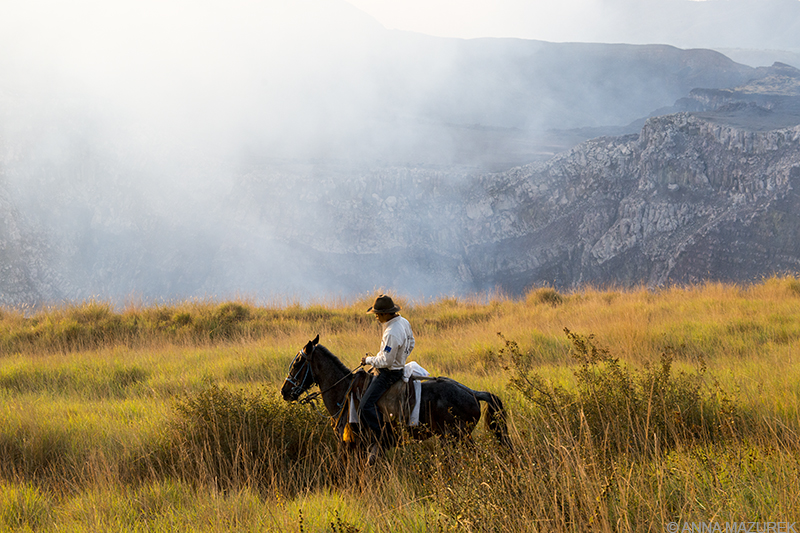
A Photo Guide to Nicaragua

Smoke rising up from the Masaya Volcano crater
I kicked off 2016 with by visiting my 44th country – Nicaragua. It was the perfect place to defrost from winter, eat my weight in papaya, climb colonial church towers and hike volcanos. Nicaragua is shaking off decades of political turmoil and slowly emerging from obscurity onto the main travel circuit. It’s still much cheaper and undeveloped than neighboring Costa Rica. Fingers crossed that it continues to stay under the radar.
Here’s my list of the top five must-see sights in the country:
1. Ometepe
My favorite part of Nicaragua was Isla de Ometepe—a mystical island with twin volcano peaks in the middle of a fresh water lake. A good portion of the island is undeveloped with unpaved roads. It was a great place to hike, swim and relax in a hammock. It was completely different (and safer) than the rest of Nicaragua.
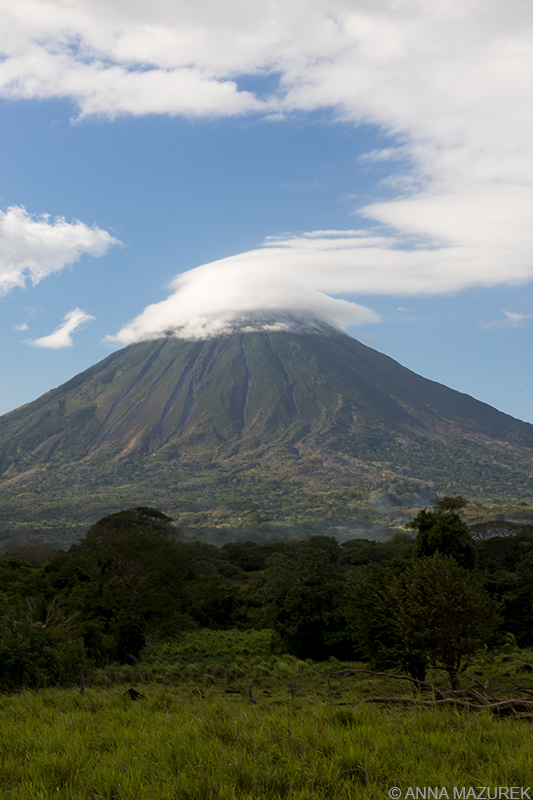
Concepción, the larger of the two volcanos on Ometepe
I stayed in one handmade cottages at Finca Mystica, an ecofriendly jungle lodge. The food, accommodation and location were amazing. (In ALL of my travels, this is in my top three for accommodation!) Nothings beats waking up to the sound of howler monkeys every morning!
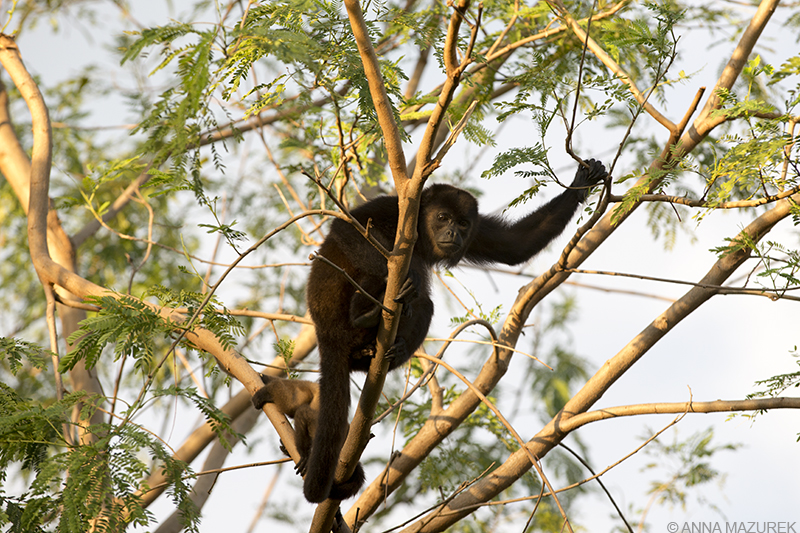
Howler monkeys in the trees outside my cabin at Finca Mystica on Ometepe
Other island highlights include:
- Café Campestre, a great lunch spot in Balgue
- San Ramon Waterfall (pictured below), a good hike that leads to small, picturesque waterfall
(Don’t rent a horse. It’s easier and less painful to hike. Trust me on this one.) - Ojo de Agua, a natural spring pool fed by an underground river from the Maderas volcano
- Playa Santa Domingo, a beautiful 4km long black sand beach
- Hiking the Maderas (6-8 hours) and Concepción (10 hours) volcanos
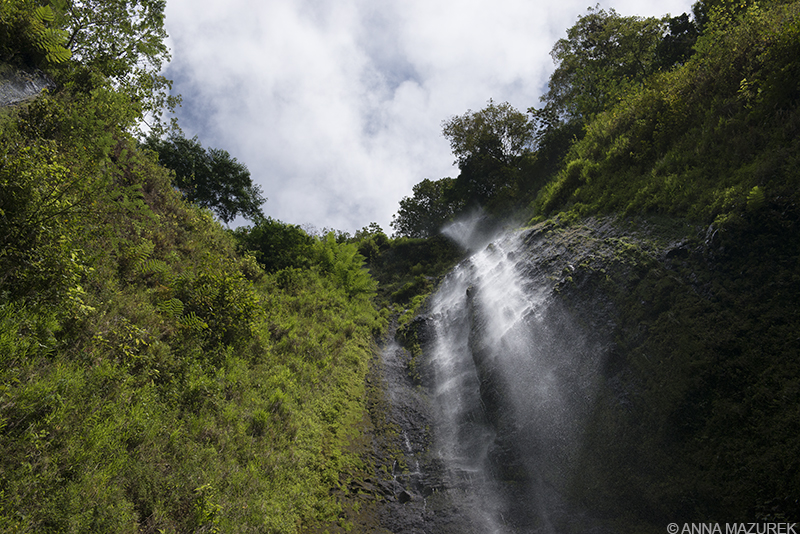
San Ramon Waterfall on Ometepe
The island is located in Lake Nicaragua, which is the rumored site of the proposed (and recently postponed) Nicaragua canal funded by a Chinese businessman. Transport: Ferries leave San Jorge regularly for Ometepe. Avoid the small ferries, which are sketchy and the bottom level floods. Opt for the larger three-level car ferries instead.
2. Granada
The colorful colonial streets of Granada are the most photogenic and best preserved in the country. Highlights include the Cathedral de Granada, the main icon of the city skyline, and Iglesia San Francisco, the oldest church in Central America that also houses a museum. Soy Nica is a great shop for locally made leather goods. For an amazing view of the city, climb the tower of Iglesia de La Merced in the late afternoon. Where to eat: The best lunch spots are El Garaje (one of my favorite meals in Nicaragua with a weekly rotating menu) or The Garden Café, a popular spot with large courtyard.
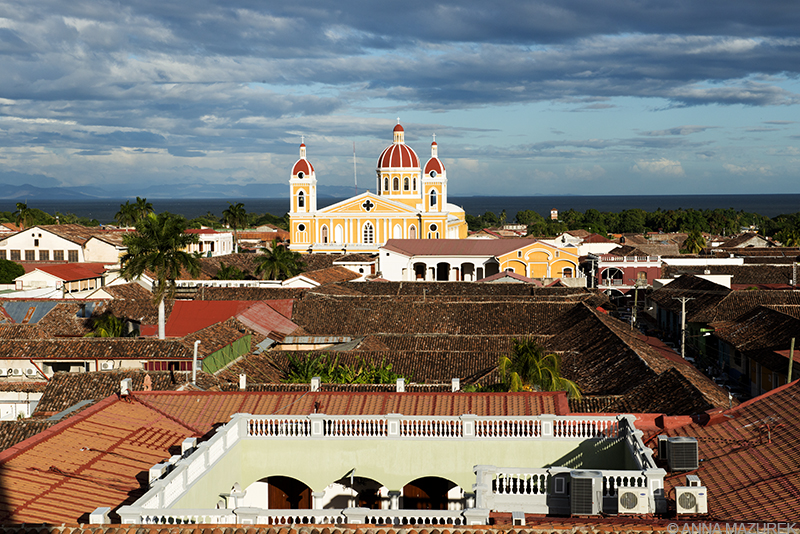
Sunset view of the Granada Cathedral from the tower of Iglesia de La Merced
3. Laguna de Apoyo
The giant crater lake is a short drive from Granada and is the clearest body of fresh water in the country. It was formed 23,000 years ago and was declared a nature reserve in 1991. There are a handful of accommodation options on the lake that offer kayaks and paddleboards. I highly recommend a sunrise kayak along the shoreline.
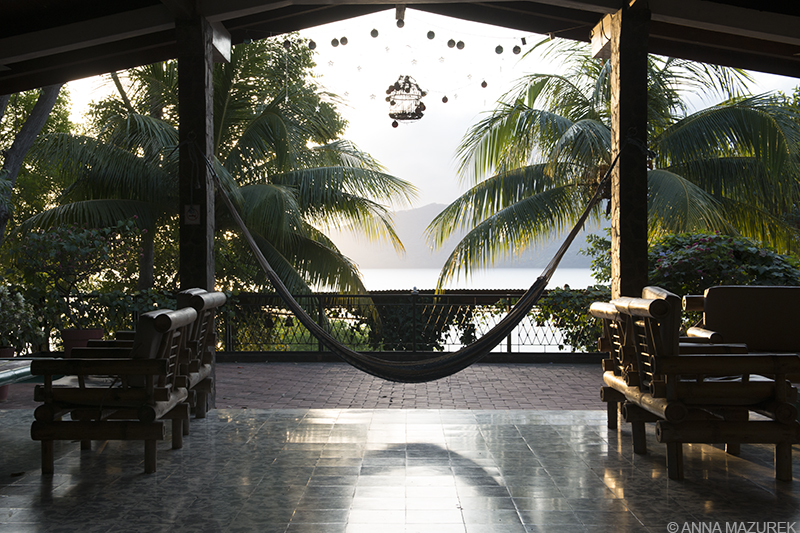
Sunrise at Hostel Paradiso at Laguna de Apoyo
4. León
The highlight of León for me was the roof tour of the cathedral (Basílica de la Asunción), which is the largest cathedral in Central America. Despite offering an amazing view of the city and surrounding volcanos, the maze-like rooftop itself was stunning. Shoes are not allowed because the roof was recently painted bright white.
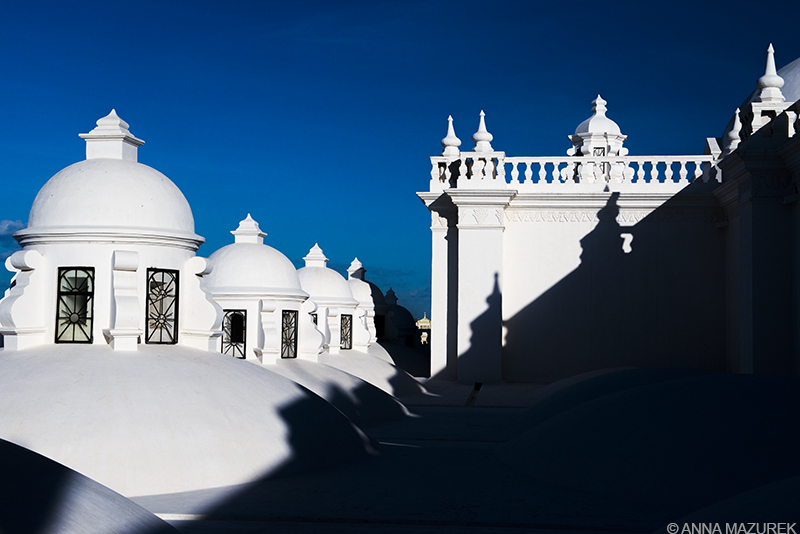
Roof of Basílica de la Asunción in Leon
Another must-see is the Museo de Arte Fundación Ortiz-Gurdián, one of the finest contemporary art museums in Central America. Two beautiful old homes are filled with the works of Latin American masters including Diego Rivera and Fernando Botero along with a few big names like Picasso and Chagall. The $3 entrance fee was a steal.
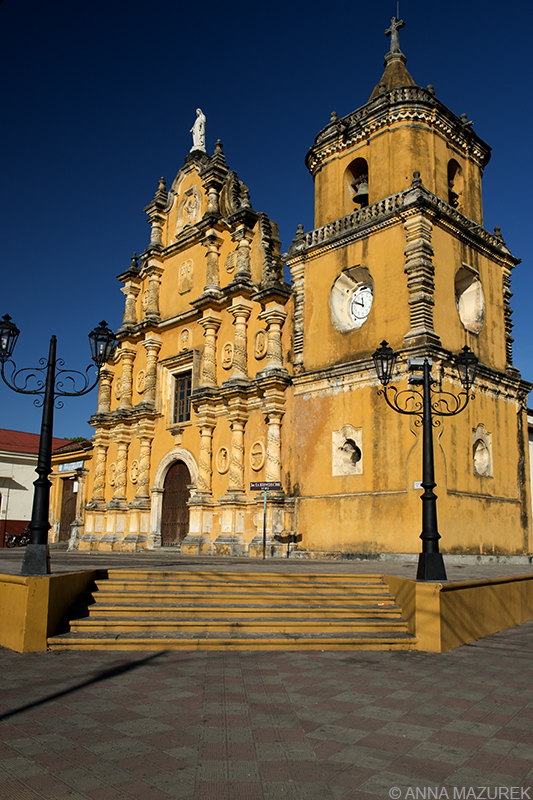
The heavily decorated yellow façade of the 1786 Iglesia de Recolección in Leon
Where to eat in León: Be sure to stop for breakfast at Pan & Paz, grab an afternoon ice cream on a waffle cone (both are homemade) at Kiss Me and dinner at El Bodegon (my favorite restaurant in Nicaragua). It’s run by a Cuban chef and has a set 180 córdoba ($6) menu featuring giant quesadillas and Spanish tortillas.
5. Cerro Negro
Volcano boarding at Cerro Negro, a 728-meter active volcano, was on my bucket list. The volcano is named for the layer of volcanic rocks that cover its slopes. (The last eruptions was 1999.) Many tour companies like El Perezoso offer the day trip for $30 USD from León and provide boards (homemade sleds) and safety gear. It took a little less than an hour to hike to the top with my board strapped to my back and less than two minutes to come down! (It honestly was nowhere near as scary as I thought.) Go early to beat the crowds and party hostels who arrive around 9:30 a.m.
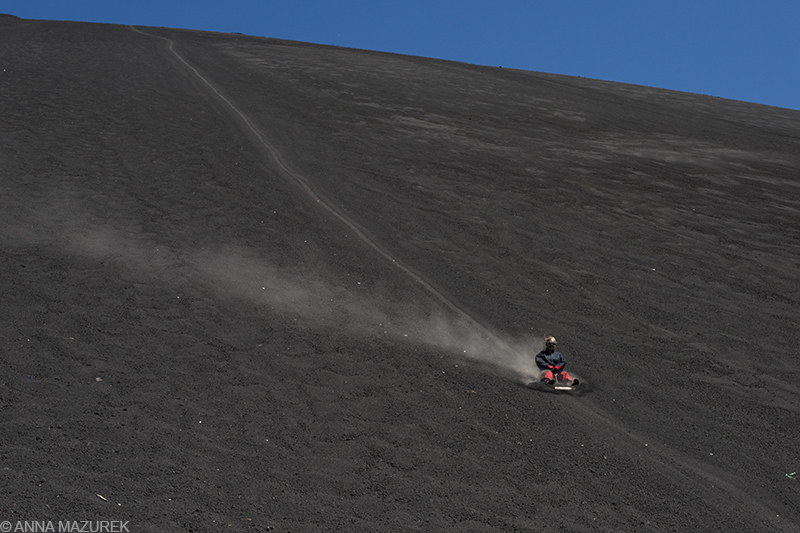
Volcano boarding on Cerro Negro near León
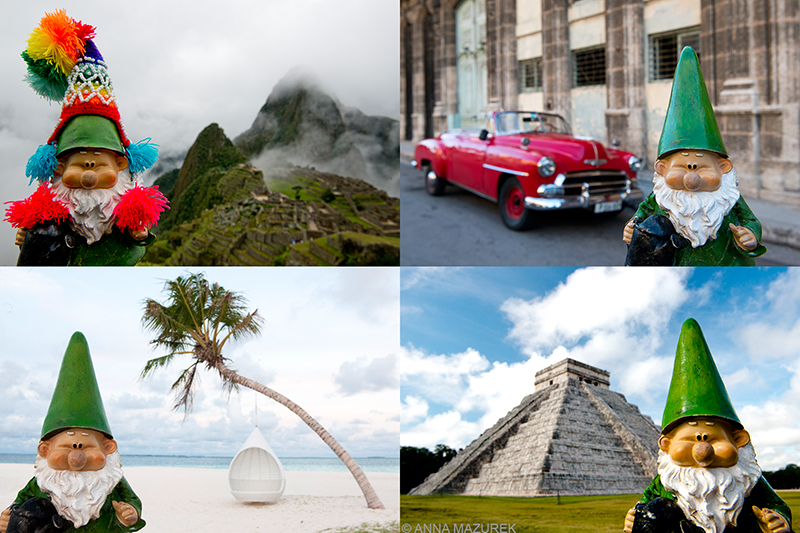
Meet Alfred – the Globetrotting Gnome

Clockwise from top left: Machu Pichu, Peru; Havana, Cuba; Chichen Itza, Mexico; Maldives
For the past eight years, I have traveled the world solo with my little photogenic gnome. Alfred’s been my favorite travel buddy since our paths crossed on the garden aisle of a supermarket in Sydney. Since then, we’ve been to five continents together and countless road trips in the U.S.
The idea to photograph a gnome did not come from Travelocity or the French film Amélie. (I saw the movie years later.) It started at 6 a.m. in June of 2006 when I picked up my best friend from high school for an East Coast road trip to Maine from my hometown in South Carolina. I noticed Harvey on the porch when we were leaving. He was laying on his side and covered in a layer of spider webs. I instantly knew he was coming with us.
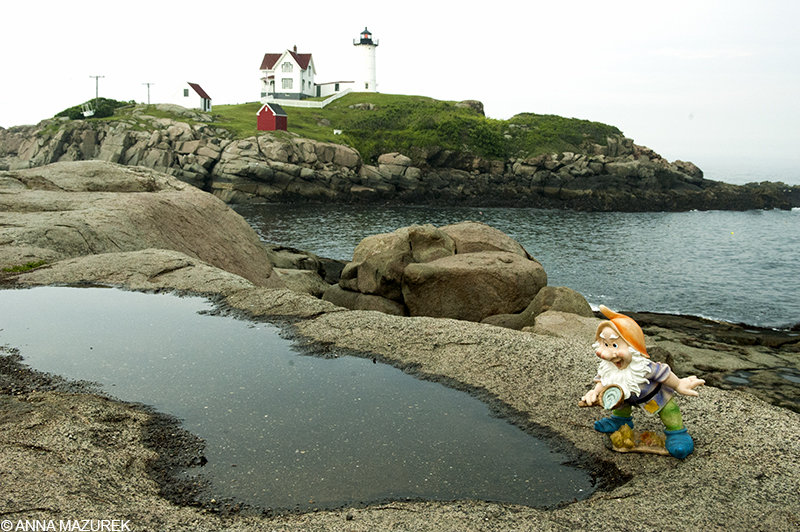
The original gnome Harvey (who closely resembles Happy the dwarf from Snow White) in Maine in July 2006.
Some frat boys stole Harvey off my friend’s porch a few years later. My first gnome was Albert. He met a tragic end in Niagara Falls. My second gnome was Walt. He was about 18 inches tall with a little bird on his head. When I moved to Australia in 2008, there was no room for him in my suitcase so he went to live with my nephew. I was gnomeless for a few months until that day in Sydney when I stumbled upon a little row of travel-sized gnomes. (Alfred is 8.5 inches tall.)
Alfred barely survived a traumatic experience at the Leh airport in Northern India in 2011. As I was being patted down by an airport security guard, the luggage conveyer belt got jammed, and my bag tumbled to the ground. Alfred was in pieces, and I cried the entire one-hour flight to Delhi. I quickly learned the Hindi word for “superglue” and went off to find a market. My amazing friend, Justin, helped glue him back together. (REAL friends stay up late to help you glue your gnome back together even though you have to be up at 5 a.m. to go to the Taj Mahal.) When I got back to the States, I went straight to a hardware store and bought some spray foam insulation to make Alfred a bit sturdier.
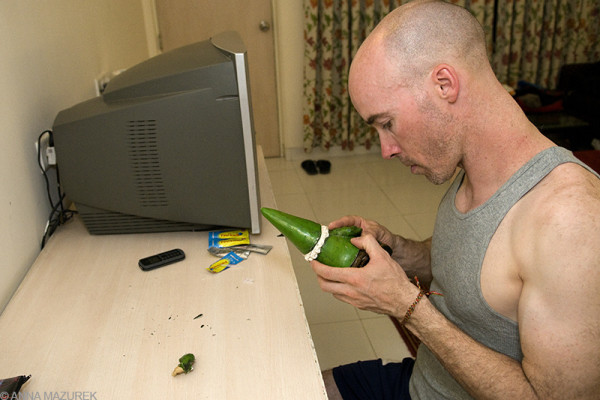
Justin helps glue Alfred back together in Agra after his tragic airport accident in India.
Alfred now travels in a $40 indestructible Pelican case. I keep a 4×6 photo collage (like the first image in this post) with him just in case I need to provide explanation at the airport. He is pretty popular among the airport security staff. In Costa Rica, one of the guards asked me to open the case and called all the other guards over to meet Alfred. They all flooded me with questions: “What’s his name?” “Where’s he been?” Meanwhile, my friends were all convinced I was being arrested.
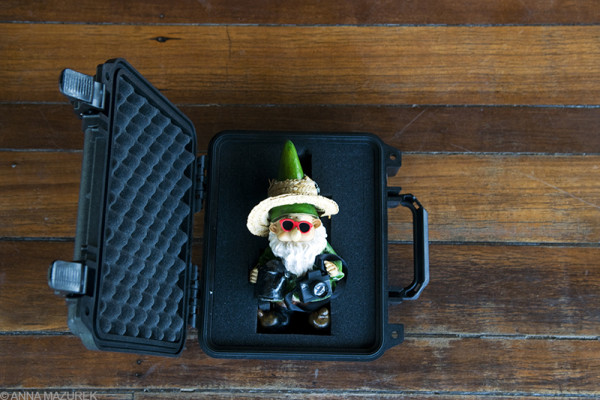
Alfred’s Pelican Travel Case
I started photographing Alfred everywhere I went but mostly in places with iconic backgrounds that could be easily recognized. I also started making gnome Christmas cards for my friends every year and a few other holiday-themed cards (Easter, St. Patrick’s Day, etc.) that I sold at art shows occasionally. Every year it takes hours and hours to make, write and mail all my Christmas cards to my amazing friends who are scattered across the globe. My goal is always to make them smile, and it’s my favorite part of the holidays. Everyone needs a gnome in their mailbox!
Most of all, I hope Alfred inspires people to travel. If a tiny green gnome can travel the world, why can’t you?
To see more of Alfred’s adventures, check out his travel gallery!
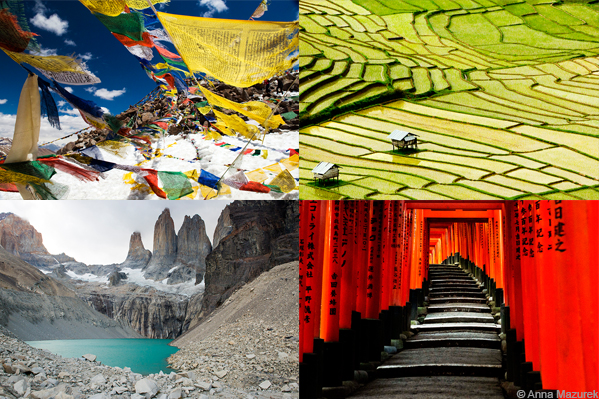
Ten Reasons Why You Should Travel Solo

Four of my favorite places from the past eight years of traveling (clockwise from left): Ladakh, India; Northern Thailand; Fushimi Inari Shrine, Kyoto, Japan; Torres del Paine, Chile
After traveling nonstop for over eight years, I prefer traveling solo, an idea that frightens many people. When the economy tanked in 2008, I quit my jobs and spent a year globetrotting. (Recessions aren’t good for freelance photographers.) It was my first long-term solo adventure—eight countries in 13 months. I booked the flight and never looked back.
If you have never traveled solo, here are a few reasons to pack your bags:
1. Expand Your Comfort Zone
The only way to overcome fear is to do the things you fear. Almost everything I do scares me. I hate heights so I went bungee jumping in New Zealand. I find the idea of being alone in a foreign city where I don’t speak the language to be exhilarating. The courage and confidence gained from traveling alone can transform every aspect of your life including your career.
2. Be Master of Your Own Schedule
Traveling solo is the ultimate freedom. Eat pancakes for breakfast everyday. Get up at sunrise to go hiking or spending your afternoons reading in a hammock. No dragging your night owl friends out of bed to catch an early flight. And, most importantly, no fighting over what to eat for dinner! You do what you want when you want. No waiting. No silly fights. No questions.
3. Learn about Yourself
I consider travel to be an education – an in-depth look at world history and yourself. I had a Master’s degree by age 25 and lived on four continents by the time I was 27. There is a clarity that comes from being 5,000 miles away from everything familiar and all the things that influence your decisions. It cleared my head of society’s expectations and allowed me to simplify my goals and priorities to build the life I wanted, which involved traveling for a living.
4. Make New Friends
The easiest way to meet people is to travel alone. It forces you to be more outgoing than normal, and it makes you more approachable. Conversations with strangers are easier and more natural because they revolve around simple questions like “Where are you going?” and “Where are you from?” Plus, other travelers are the best resource for recommendations for food, transport and accommodation. You will never run out of conversation topics!
I met the majority of my closest friends while traveling. Each one started as a chance meeting in an unlikely place – a pub in chilly Northern England and the humid streets of Luang Prabang. I couldn’t imagine my life without these people.
5. Easier to Plan
The stress of planning is significantly reduced when you only have to plan for one. It’s easier to find a single spare seat on a last minute flight or a sold-out bus. Plus, you don’t have to coordinate multiple work and vacation schedules. I usually book a one-way flight to leave my options open.
6. Save Money
It’s easier to stay within your budget when you are traveling solo. Everyone has different comfort levels, which can lead to drastic price differences for accommodation, food and transport. I usually prefer to walk or take public transport for both the experience and to save money. I’ve traveled with friends who insist on taking taxis everywhere because they can’t take the crowds and heat. (For travel funding tips, check out my guide to eliminating bills, travel banking 101 and savings tips.)
7. No Regrets
The best way to live the life you daydream about is to travel alone. People often tell me, “I live vicariously through your travels.” Well, I prefer to live vicariously through myself. If I want to do something, I find a way to make it happen. Sometimes it can take weeks, months or years. I refuse to spend my life waiting on other people. If friends can join me for an adventure, then great. If not, then I go alone. When I’m 80-years-old, I will never say, “Man, I regret that year I spent living in Australia and those two months I spent hiking in Patagonia.”
8. Minimalism
I was THAT girl. The one dragging two suitcases twice her size through the airport. Thankfully, that girl has learned to carry-on her luggage. Nothing teaches you about minimalism better than a long-term solo trip. When you are alone, there’s no one to watch your luggage while you run to the bathroom or grab a coffee. An overload of luggage makes any traveler an easy target for thieves and unwanted attention. Plus, giant bags will kill your back, energy level and mood.
9. Singing in the Car
The best part of road trips is singing horribly loud to your favorite ‘90s mix with no one to judge you or roll their eyes. Nothing makes the miles pass as quickly as singing and dancing in the car.
10. Inspire Others
My courage to travel solo across five continents has inspired my friends to take advantage of gaps of time to join me for a small part of a trip or take their own journey. I am the excuse people use to travel and face their fears. Be the inspiration for your friends to take that trip to Cuba or hike Kilimanjaro!
(This is a post I wrote for Afar.com a few months ago.)
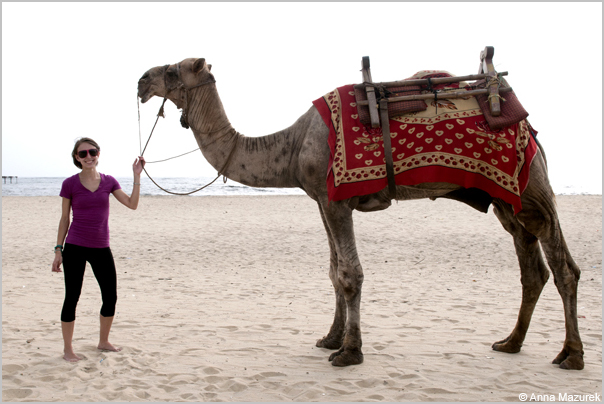
The Myth About Travel & Luck

Kerala, India
“You’re so lucky that you get to travel so much!”
“I’m jealous of your life!”
“I’m living vicariously through you!”
Let me let you in on a big secret: Travel has nothing to do with luck. Luck is finding a $10 bill on the sidewalk.
All I have wanted to do is travel. I didn’t grow up traveling, but I found a way to make it happen. The first time I stepped on a plane, I was 19. The next year I moved to England to study abroad. Fast forward a little over a decade, I’ve been to 44 countries on five continents; I lived in five states and five countries. Eight-year-old Anna would be so proud of 34-year-old me.
How do I travel so much? First of all, I don’t have a trust fund. I found jobs that paid me to travel. I taught English in Thailand, freelanced for travel/lifestyle magazines and ran photo trips in Asia. (Many of these gigs paid for my travel and living expenses.) Sometimes I worked three jobs to save money to travel on my own – I worked as a freelance photographer but also waited tables/bartended, worked retail and taught university photo classes. I cut all unnecessary expenses. Every decision I made was for my next adventure. I even rented out a friend’s living room for $230 a month when I first moved to Austin and slept on an air mattress to save money for my South America trip. (Vagabonds like me don’t sign leases.) I have quit countless jobs—even jobs that I loved—to travel. Do you have to work three jobs to be able to afford to travel? Do you have to quit your job and sleep on an air mattress in your friend’s living room? Do you have to do exactly what I did to travel? Absolutely not.
If I want to do something, I do it. It’s that simple. Sometimes it takes weeks, sometimes it takes months or even years. Regardless, I MAKE it happen. I travel because it makes me feel alive and believe everyone should do the things that make them feel alive.
The secret to traveling and living your daydreams comes down to three things: priorities, relentless persistence and courage.
1. Priorities
The great paradox of life is the relationship between money and time. You either have an abundance of one or a shortage of the other. Write down a list of your top three priorities. Find ways to make time or funding for them. Eliminate anything that gets in the way. Sometimes that means eliminating things you want to do – saying no to a dinner with a friend in order to work on a personal project or to save money. Follow the 80/20 rule: Invest your time in 20% of your actions that provide 80% of the results in your life.
2. Relentless Persistence
I refuse to be ignored. That’s how I got hired to shoot for countless magazines. I cold called and emailed until I got a meeting. After the meeting, I stayed on their radar and got access to events I knew they were covering. My persistence got me the job almost every time.
When something I’ve been working hard for falls through, I also accept that the timing isn’t right. My schedule is simply clearing up so I can focus my time on something else. Regardless, my goal remains the same even though my methods and direction may change.
3. Courage
I admit it – I hate to fly. But, I love to travel more than I hate to fly so I do it anyways. I refuse to let fear control my actions or regrets to control my life. When I’m 80, I’d rather talk about my globetrotting adventures instead of the time I was too scared to get on the plane.
What is stopping you? Write down the obstacles in your way and find a solution for each. Everything I do scares me and that’s exactly why I do it. The secret is to break big challenges into small manageable steps. The idea of moving to England alone to study abroad was overwhelming at first. (It was my third time flying and first trip overseas.) I broke it down into smaller pieces. All I had to do was get on the plane. That was my first goal. Once I was on the plane, I focused on the next goal, etc.
Now, I challenge you to go do the things you want to do! The minute you do, the world will start to notice.
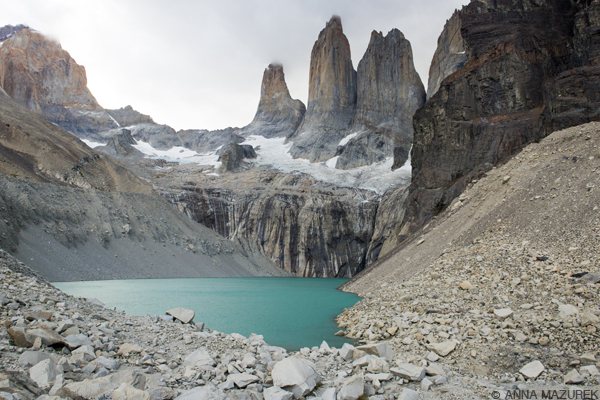
My Top 10 Travel Photographs (and Adventures) of 2015
2015 was a big year of travel for me! I kicked the year off in Panama City, Panama trying to figure out the best (and cheapest) way to get to Cartagena. It has been one amazing adventure full of new places, faces and reunions with old friends. I spent the first five months in South America and traveled by bus from Ushuaia (the southern most city in the world) at the bottom of Argentina all the way north to Cusco, Peru. Here are my top 10 favorite photographs from my adventures in 2015:
1. Torres del Paine
I spent two months in Patagonia at the beginning of the year and spent five days hiking the “W” circuit at Torres del Paine in Southern Chile. It was the biggest hike I did in South America and one of the most challenging for me. (It was the first time I’ve backpacked carrying both camera and camping gear.) The last hour of the hike to the three towers was brutal, but the view was incredible.
2. Cartagena
The party never stops in colorful Cartagena. I spent a few weeks here in January exploring the colonial town and meeting up with some old friends. My visit coincided with the Cartagena International Music Festival. There’s nothing quite like listening to classical music in an old colonial square.
3. Machu Picchu
Meet Alfred – the globetrotting gnome. Clearly, this hat was made for a gnome. I’ve photographed Alfred on five continents over the past six years. He’s an Australian gnome. It was love at first sight at the garden section of K-mart in Sydney. I started making funny gnome cards for my friends and later began to sell them on Etsy because people loved them so much. If a tiny green gnome can travel the world, why can’t you?
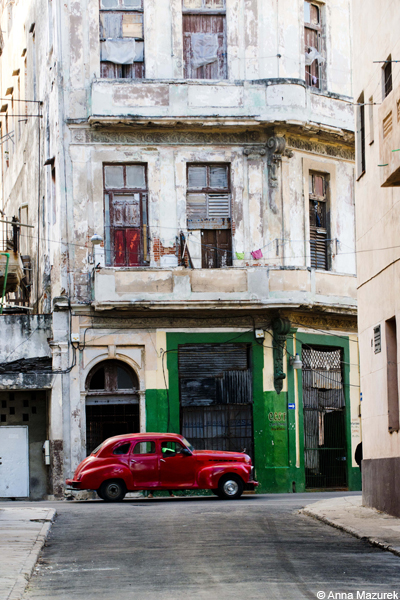
4. Havana
It is nearly impossible not to fall victim to the charms of Havana. The drive from the airport to the city center felt as if the clock was rewinding back 60 years. It will always be one of my favorite cities.
5. Arequipa, Peru
The Santa Catalina Monastery is a photographer’s dream. Built in 1580, the maze-like fortress covers an entire block and is filled with colorful courtyards and cobblestone streets. I spent hours walking the alleys until the light vanished.
6. Salar de Uyuni, Bolivia
My friend Manon took this great photo of me on the salt flats in Bolivia. We woke up at 4 a.m. to reach the flats by sunrise. I will never forget the moment the jeep drove onto the flats – an endless sea of white stretched out to greet the pink horizon. I was on a jeep tour with five other travelers—an amazing group of people I’d met on the road. I met three girls (from Switzerland, Belgium and Holland) on a bus crossing the Andes a few days before. They joined me and an Australian couple I met in Argentina on the jeep tour. The best part of traveling is the amazing people you meet!
7. Iquitos, Peru
I choose Iquitos for my Amazon adventure due to it’s remoteness. Despite being the largest city in the Peruvian Amazon, it is only accessible to the world by plane or boat. The wildlife was incredible. Woolly monkeys like the one above were everywhere in the jungle.
8. Uruguay
The crumbling colonial town of Colonia del Sacramento was a charming surprise. The former Portuguese settlement and UNESCO World Heritage site is 50 km from Buenos Aires by ferry. The main purpose of my trip to Uruguay from Argentina was to get US dollars to exchange on the black market for a higher rate in Argentina. (ATMs in Uruguay allow you to withdraw both USD and the local currency.) The town ended up being a great place to photograph. I can’t wait to go back and explore more of the country!
9. Northern California Redwoods
At the end of every big trip, I tack on a smaller trip to visit friends in the States. I flew to San Francisco and road tripped up to the Avenue of the Giants in Northern California with my friend Miles. I try to divide my time between exploring the world and my own country. (My travel digits are currently at 43 countries and 37 states.)
10. Marfa
I love Marfa – a quirky, artsy small town in West Texas. There is an art installation of a mini fake Prada store about 36 miles west of the town. On my first visit in 2014, the store had been vandalized so I wasn’t able to get the photographs I wanted. In October, I drove the six hours back to Marfa and finally got the perfect shot!
COMING UP
I am starting off 2016 with a quick trip to Nicaragua! I’ve got some exciting stories lined up to help you live up to your travel potential in 2016! Let me know what travel questions or topics you want to hear about on the blog. Email me suggestions or leave them in the comments below. Feel free to sign up for the email list to have every post delivered to your inbox! Happy New Year and safe travels!
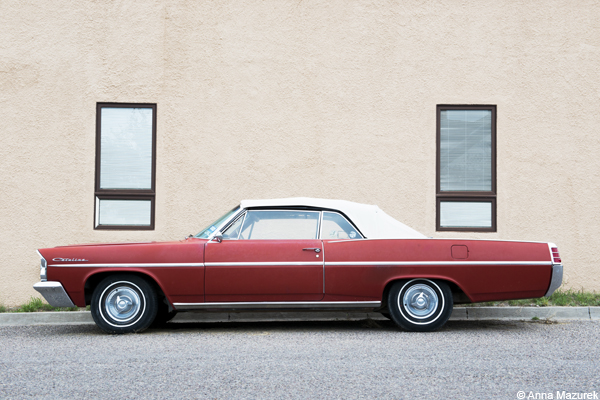
Five Ways to Travel Better in 2016
As the year wraps up, I encourage you to start thinking about your travel resolutions for 2016. I wanted to share a post I wrote for Afar.com a few weeks ago about how to travel smarter, longer and lighter next year!
Here are five ways to make make travel a priority in 2016 and maximize your vacation time:
1. Maximize Weekends. When I studied abroad in England, I spent every weekend exploring and saw more of the country than my local friends who had lived there for decades. I did the same when I moved to Austin, Texas. I took road trips to Marfa, Houston, Big Bend National Park and every quirky, photogenic town people recommended.
Write down a list of places you’ve always wanted to visit but take for granted due to their proximity. Once a month, plan a trip to explore areas closer to home – nearby towns, national parks and attractions within your state. Take friends or family along for a fun day or quick overnight trip.
2. Travel Lighter. Learn to pack smarter and carry on all luggage. I always start packing a few days before a big trip. (It’s way too easy to over pack when I am rushed!) Then, I spend a few minutes each day eliminating items down to only the bare essentials. Packing lighter saves time at the airport because I skip the baggage check line and get to sleep in a few extra minutes!
Pack complimentary colors to maximize outfit options. Limit your shoes to two pairs. Roll clothing to make more space in your bag. No matter where you go, there will be laundry services!
3. Workout. Travel isn’t an excuse to abandon your exercise routine. Instead, use your workout as a reason to explore a new city. (My favorite thing to do on my first morning in a new place is to go for a sunrise run while the tourists are still asleep.) Bike the local neighborhoods, climb a volcano or go sandboarding! Join a tour or do it solo! Either way, you’ll get a more authentic look at the culture.
Consider planning your trip around activities are that are both physically challenging and rewarding. Hike the Inca Trail or the W circuit at Torres del Paine. Climb Kilimanjaro or trek to Everest Base Camp! Push your limits and comfort zone. The stories will be priceless!
4. Take Longer Trips. It’s cheaper to travel for longer periods of time than to take multiple trips. Flights are usually the most expensive part of travel. Once you arrive in a destination, it’s much easier and cheaper to country hop than to take additional trips. Spending a month or three in Southeast Asia is always cheaper than multiple visits.
How do you find the time? For me, it was simple. I took advantage of gaps of time between jobs and after graduation from both college and graduate school. I also quit multiple jobs to travel. Each time I was honest about my reasons for leaving and even got rehired when I returned!
Glance at your work schedule for the year. Devise a detailed plan that allows you to take an extended trip without affecting your productivity. Meet with your boss face-to-face to outline your plan and/or discuss options to work remotely. Be honest and direct. And, offer to bring him back a nice bottle of Argentinean malbec!
5. Start Collecting Miles. I wrapped up a seven-month trip in Central/South America earlier this year. I flew fifteen times and only paid for four flights. The rest were paid for with miles that I collected from traveling (for both work and personal trips) and rewards credit cards.
What’s my secret? Sign up for a rewards credit card and frequent flyer mile accounts at each of the major airlines in your country. The initial sign-up bonus offered by most rewards cards is enough for one free flight! Take advantage of online shopping malls offered by rewards credit cards. Simply click on their customized link to popular retailers (Sephora, Apple, Target, etc.) to earn miles. (This isn’t an excuse to spend frivolously but to collect points of your normal purchases and holiday shopping!)
Don’t forget to collect miles for work travel for flights, hotels and rental cars. (Despite who pays, the person who flies gets the miles!) Double dipping is also key. Hotel loyalty programs like Hilton HHonors let you earn a combination of hotel points and airline miles for every dollar spent on a hotel stay.
COMING UP: Next week, I’ll be posting my favorite travel photos from my 2015 adventures!

